Beijer ELECTRONICS GT-5122 High Speed Counter Module

This manual contains information on the software and hardware features of the Beijer Electronics GT-5122 High Speed Counter Module. It provides in-depth specifications, guidance on installation, setup, and usage of the product.
Symbols Used in This Manual
This publication includes Warning, Caution, Note and Important icons where appropriate, to point out safety-related, or other important information. The corresponding symbols should be interpreted as follows:
 WARNING
WARNING
The Warning icon indicates a potentially hazardous situation which, if not avoided, could result in death or serious injury, and major damage to the product. CAUTION
CAUTION
The Caution icon indicates a potentially hazardous situation which, if not avoided, could result in minor or moderate injury, and moderate damage to the product. NOTE
NOTE
The Note icon alerts the reader to relevant facts and conditions. IMPORTANT
IMPORTANT
The Important icon highlights important information.
Safety
- Before using this product, please read this manual and other relevant manuals carefully. Pay full attention to safety instructions!
- In no event will Beijer Electronics be responsible or liable for damages resulting from the use of this product.
- The images, examples and diagrams in this manual are included for illustrative purposes. Because of the many variables and requirements associated with any particular installation, Beijer Electronics cannot take responsibility or liability for actual use based on the examples and diagrams.
Product Certifications
The product has the following product certifications.

General Safety Requirements
WARNING
- Do not assemble the products and wires with power connected to the system. Doing so cause an “arc flash”, which can result in unexpected dangerous events (burns, fire, flying objects, blast pressure, sound blast, heat).
- Do not touch terminal blocks or IO modules when the system is running. Doing so may cause electric shock, short circuit or malfunction of the device.
- Never let external metallic objects touch the product when the system is running. Doing so may cause electric shock, short circuit or malfunction of the device.
- Do not place the product near inflammable material. Doing so may cause a fire.
- All wiring work should be performed by an electrical engineer.
- When handling the modules, ensure that all persons, the workplace and the packing are well grounded. Avoid touching conductive components, the modules contain electronic components that may be destroyed by electrostatic discharge.
CAUTION
- Never use the product in environments with temperature over 60℃. Avoid placing the product in direct sunlight.
- Never use the product in environments with over 90% humidity.
- Always use the product in environments with pollution degree 1 or 2.
- Use standard cables for wiring.
About the G-series System
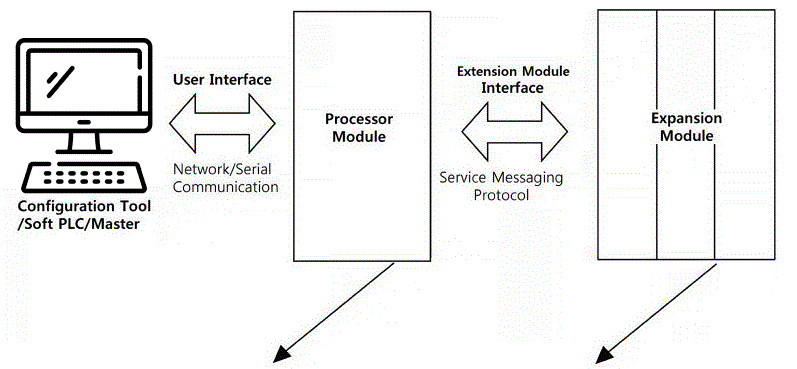
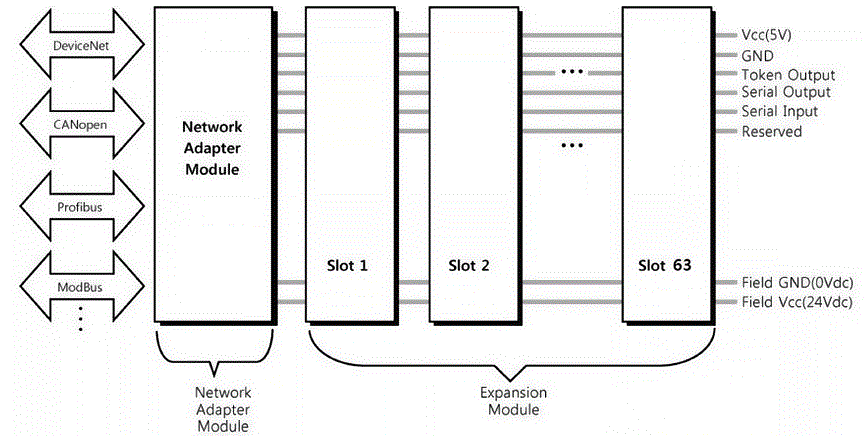
System overview
- Network Adapter Module – The network adapter module forms the link between the field bus and the field devices with the expansion modules. The connection to different field bus systems can be established by each of the corresponding network adapter module, e.g., for MODBUS TCP, Ethernet IP, EtherCAT, PROFINET, CC-Link IE Field, PROFIBUS, CANopen, DeviceNet, CC-Link, MODBUS/Serial etc.
- Expansion Module – Expansion module types: Digital IO, Analog IO, and Special modules.
- Messaging – The system uses two types of messaging: Service messaging and IO messaging.
IO Process Data Mapping
An expansion module has three types of data: IO data, configuration parameter, and memory register. The data exchange between the network adapter and the expansion modules is made via IO process image data by internal protocol.
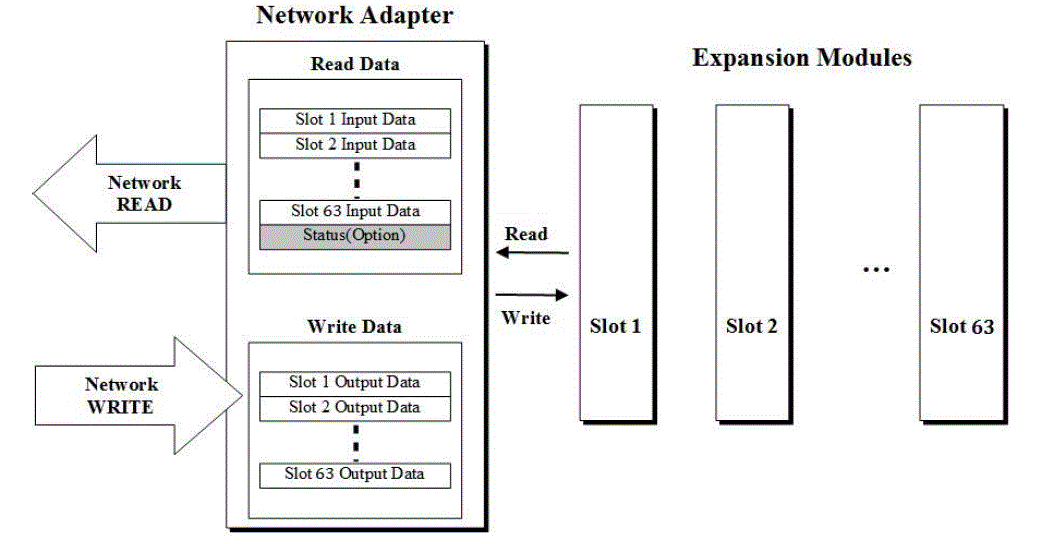
- Data flow between network adapter (63 slots) and expansion modules
- The input and output image data depend on the slot position and the data type of the expansion slot. The ordering of input and output process image data is based on the expansion slot position. Calculations for this arrangement are included in the manuals for network adapter and programmable IO modules.
- Valid parameter data depends on the modules in use. For example, analog modules have settings of either 0-20 mA or 4-20 mA, and temperature modules have settings such as PT100, PT200, and PT500. The documentation for each module provides a description of the parameter data.
Specifications
Environmental Specifications
| Operating temperature | -20°C – 60°C |
| UL temperature | -20°C – 60°C |
| Storage temperature | -40°C – 85°C |
| Relative humidity | 5% – 90% non-condensing |
| Mounting | DIN rail |
| Shock operating | IEC 60068-2-27 (15G) |
| Vibration resistance | IEC 60068-2-6 (4 g) |
| Industrial emissions | EN 61000-6-4: 2019 |
| Industrial immunity | EN 61000-6-2: 2019 |
| Installation position | Vertical and horizontal |
| Product certifications | CE, FCC, UL, cUL |
General Specifications
| Power dissipation | Max. 120 mA @ 5 VDC |
| Isolation | I/O to logic: Photocoupler isolation |
| UL field power | Supply voltage: 24 VDC nominal, Class 2 |
| Field power | Supply voltage: 24 VDC nominal Voltage range: 15 – 28.8 VDC Power dissipation: 15 mA @ 24 VDC |
| Wiring | IO cable max. 0.823 mm² (AWG 18) |
| Weight | 63 g |
| Module size | 12 mm x 109 mm x 70 mm |
Dimensions
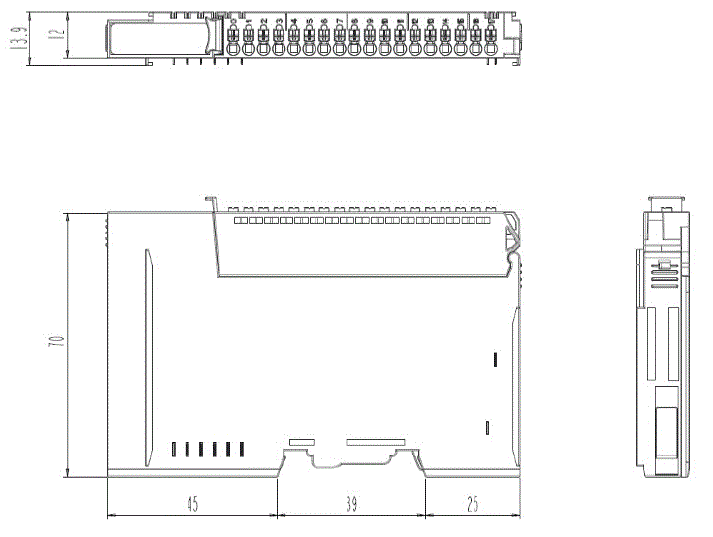
Module dimensions (mm)
Input Specifications
| Number of channels | 2 Channels. Encoder, High speed counter, Frequency measurement, Pulse width, Period measurement. | |
| Indicators | 6 green terminal input | |
| Input voltage | 5 – 24 VDC nominal (max. 28.8 VDC) | |
| Input current | 4 – 11 mA @ 24 VDC | |
| Min on-state voltage | ≥4.8 VDC | |
| Input frequency | Counter mode | 0 – 500 kHz |
| Encoder mode |
|
|
| Counting mode * | Counter mode |
|
| Encoder mode | 2-Input mode: Encoder 1x, Encoder 2x, Encoder 4x | |
| Gate function mode | Store / Continue, Store / Wait / Resume, Store-reset / Wait / Start, Store-reset / Start. | |
| Counter size | 32 bit-wide/channel | |
See chapter Mapping Data From the Image Table.
Digital Input Specifications
| Input per module | 2 points sink type |
| Indicators | 2 green input status |
| Input on-state voltage |
|
| On-stat current |
|
| Input signal delay |
|
| Nominal input impedance | 10.2 kΩ |
Digital Output Specifications
| Output per module | 2 points source type |
| Indicators | 2 green output status |
| Output voltage range |
|
| On-state voltage drop | Max 0.5 VDC |
| Off-state leakage current | Max. 20 uA |
| Output signal delay |
|
| Output current rating | Max. 0.3 A per channel |
| Protection |
|
Wiring Diagram
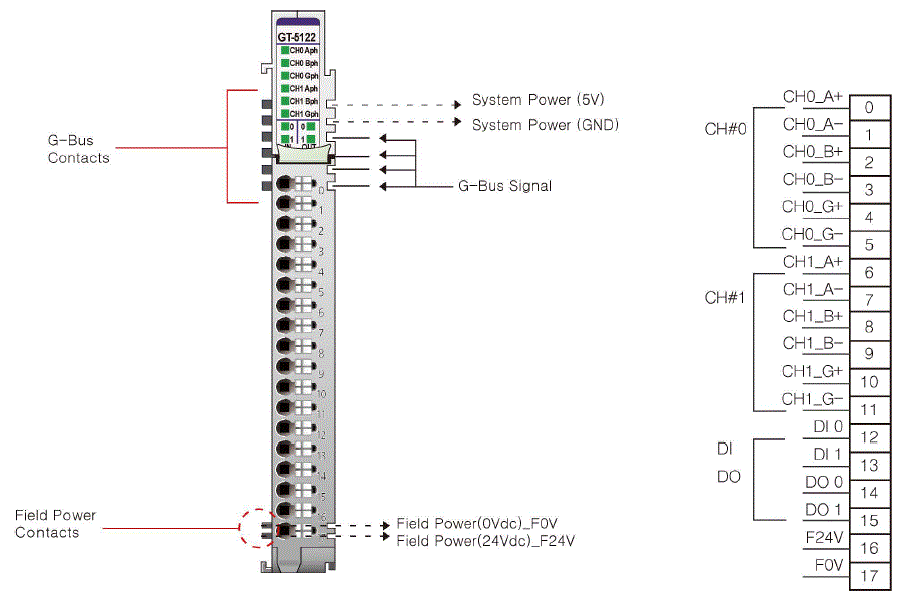
- Aph = Encoder A phase.
- Bph = Encoder B phase.
| Pin no. | Signal description |
| 0 | A ph input+ Ch#0 |
| 1 | / A ph input- Ch#0 |
| 2 | B ph input+ Ch#0 |
| 3 | / B ph input- Ch#0 |
| 4 | G ph input+ Ch#0 |
| 5 | / G ph input- Ch#0 |
| 6 | A ph input+ Ch#1 |
| 7 | / A ph input- Ch#1 |
| 8 | B ph input+ Ch#1 |
| 9 | / B ph input- Ch#1 |
| 10 | G ph input+ Ch#1 |
| 11 | / G ph input- Ch#1 |
| 12 | Input channel 0 |
| 13 | Input channel 1 |
| 14 | Output channel 0 |
| 15 | Output channel 1 |
| Pin no. | Signal description |
| 16 | Field power 24 V |
| 17 | Common (field power 0 V) |
NOTE
To support encoders with no differential signal i.e. only A+ and B+ channel without A- and B-, then connect A- and B- to the field power 0V. The reason for this is that A+ and B+ receive the signals output from the encoder, while A- and B- serve the role of establishing the reference voltage for the input signals, making their connection essential.
LED Indicator

- Aph = Encoder A phase.
- Bph = Encoder B phase.
| LED | LED function / description | LED color |
| 1 | Aph input Ch#0 | Green |
| 2 | Bph input Ch#0 | Green |
| 3 | Gph input Ch#0 | Green |
| 4 | Aph input Ch#1 | Green |
| 5 | Bph input Ch#1 | Green |
| 6 | Gph input Ch#1 | Green |
| 7 | Input channel 0 | Green |
| 8 | Input channel 1 | Green |
| 9 | Output channel 0 | Green |
| 10 | Output channel 1 | Green |
LED channel status
| Status | LED is | Indication |
| No signal | Off | No Input / Output signal |
| On signal | Green | Input / Output signal detected |
Mapping Data From the Image Table
Input image value (input image data: 10 byte)
| Bit no. | Bit7 | Bit6 | Bit5 | Bit4 | Bit3 | Bit2 | Bit1 | Bit0 |
| 0 |
|
|||||||
| 1 |
|
|||||||
| 2 |
|
|||||||
| 3 |
|
|||||||
| 4 |
|
|||||||
| 5 |
|
|||||||
| 6 |
|
|||||||
| 7 |
|
|||||||
| 8 | – | SGIN Ch#0 | SBIN Ch#0 | SAIN Ch#0 | SDN Ch#0 | SUP Ch#0 | Out status Ch#0 | Inp status Ch#0 |
| 9 | – | SGIN Ch#1 | SBIN Ch#1 | SAIN Ch#1 | SDN Ch#1 | SUP Ch#1 | Out status Ch#1 | Inp status Ch#1 |
EaCh Channel has 4 bytes input.
Counter value represents counter, frequency (Hz), pulse width (0.1 us) or pulse period (0.1 us) (when IDS = 0).
- IDS: Input Data Selection (setting by output data).
- Status Bit. The Status High can only read.
- SUP: Status Counter Up.
- SDN: Status Counter Down.
- SAIN: Status A Terminal Input.
- SBIN: Status B Terminal Input.
- SGIN: Status G Terminal Input.
NOTE
In encoder x1/x2/x4 Mode, SUP/SDN bit does not operate.
Output image value (output image data: 4 byte)
| Bit no. | Bit7 | Bit6 | Bit5 | Bit4 | Bit3 | Bit2 | Bit1 | Bit0 |
| 0 | Gate function Ch#0 | Count mode Ch#0 | ||||||
| 1 | Gate Function Ch#1 | Count mode Ch#1 | ||||||
| 2 | – | – | HRST 0 | CR 0 | CS 0 | HP 0 | DO 0 | IDS 0 |
| 3 | – | – | HRST 1 | CR 1 | CS 1 | HP 1 | DO 1 | IDS 1 |
- Count Mode Ch#0, 1: Count Mode for Ch#0, Ch#1 respectively.
- HRST 0, 1: Current counter value, stored counter value reset for Ch#0, Ch#1.
- CR 0,1: Counter Reset for Ch#0, Ch#1.
- CS 0,1: Counter Stop (inhibit input ) for Ch#0, Ch#1.
- HP 0,1: Homing Position enable/disable, when this function is enabled, the counter value set to preset value when a pulse is detected on input channel.
- DO 0, 1: General purpose Digital Output.
- IDS: Input Data Selection (0: Current counter value, 1: Store counter value).
NOTE
When the HP bit 1 → 0, counter reset is implemented. If you want to use the HP Function (Homing Position), always keep it at 1.
Gate mode Ch#0, CH#1
| Value | Description |
| B’ 0000 (0x0) | Gate function disabled |
| B’ 0001 (0x1) | Store / Continue |
| B’ 0010 (0x2) | Store / Wait / Resume |
| B’ 0011 (0x3) | Store-reset / Wait / Start |
| B’ 0100 (0x4) | Store-reset / Start |
| Others | Gate function disabled |
For more information on Gate mode, see chapter Gate Mode (Gate Function).
Count Mode Ch#0, Ch#1
| Value | Count mode | Description |
| B’ 0000 (0x0) | Up | Up counter
|
| B’ 0001 (0x1) | Down | Down counter
|
| B’ 0010 (0x2) | – | – |
| B’ 0011 (0x3) | – | – |
| B’ 0100 (0x4) | Up clock & inhibit | Up counter with inhibit
|
| B’ 0101 (0x5) | Up clock & reset | Up counter with reset
|
| B’ 0110 (0x6) | Down clock & inhibit | Down counter with inhibit
|
| B’ 0111 (0x7) | Down clock & reset | Down counter with reset
|
| B’ 1000 (0x8) | Up clock & down clock | Up & down counter
|
| B’ 1001 (0x9) | Clock & direction | Up & down with direction
|
|
||
| Value | Count mode | Description |
| B’ 1010 (0xA) | Encoder 1x * | Encoder 1x
|
| B’ 1011 (0xB) | Encoder 2x | Encoder 2x
|
| B’ 1100 (0xC) | Encoder 4x | Encoder 4x
|
| B’ 1101 (0xD) | Frequency measurement 1 s update ** | Simple frequency measurement, updated by 1 s, Hz unit
|
| B’ 1110 (0xE) | Pulse width measurement | Simple pulse width measurement, 0.1 us unit
|
| B’ 1111 (0xF) | Pulse width & period measurement | Simple pulse width & period measurement, 0.1 us unit
|
|
||
Parameter Data
Valid parameter length: 8 bytes
| Byte | Bit 7 | Bit 6 | Bit 5 | Bit 4 | Bit 3 | Bit 2 | Bit 1 | Bit 0 |
| 0 | Preset value Ch#0 LL | |||||||
| 1 | Preset value Ch#0 LH | |||||||
| 2 | Preset value Ch#0 HL | |||||||
| 3 | Preset value Ch#0 HH | |||||||
| 4 | Preset value Ch#1 LL | |||||||
| 5 | Preset value Ch#1 LH | |||||||
| 6 | Preset value Ch#1 HL | |||||||
| 7 | Preset value Ch#1 HH | |||||||
Gate Mode (Gate Function)
The gate function operates in one of the following modes:
- Store / Continue
- Store / Wait / Resume
- Store-reset / Wait
- Store-reset / Start
Store / Continue
When G ph are raising edge, the stored count value register will get counting value by current count value register. Next current count value will do counting continue. Below example picture shows timing waveforms of Store / Continue.
Store / Wait / Resume
When G Ph are rising edge, the stored count value register will get counting value by current count value register, and waits the current count value until falling edge. Next G Ph will be filling edge and current count value register resume counting. Below example picture shows timing waveforms of Store / Wait / Resume.
Store-reset / Wait / Start
When G Ph are rising edge, the stored count value register will get counting value by current count value register and current count value register reset at the same time. The current count value register waits until G Ph falling edge. Next current count value register start counting. Below example picture shows timing waveforms of Store-Reset/Wait/Start.
Store-reset / Start
When G Ph are rising edge, the stored count value register will get counting value by current count value register, and current count value register reset at the same time and the register start counting. Below example picture shows timing waveforms of Store-reset / Start.
Hardware Setup
CAUTION
- Always read this chapter before installing the module!
- Hot surface! The surface of the housing can become hot during operation. If the device is used in high ambient temperatures, always let the device cool down before touching it.
- Working on energized devices can damage the equipment! Always turn off the power supply before working on the device.
Space Requirements
The following drawings show the space requirements when installing the G-series modules. The spacing creates space for ventilation, and prevents conducted electromagnetic interference from influencing the operation. Installation position is valid vertical and horizontal. The drawings are illustrative and may be out of proportion.
CAUTION
NOT following the space requirements may result in damaging the product.
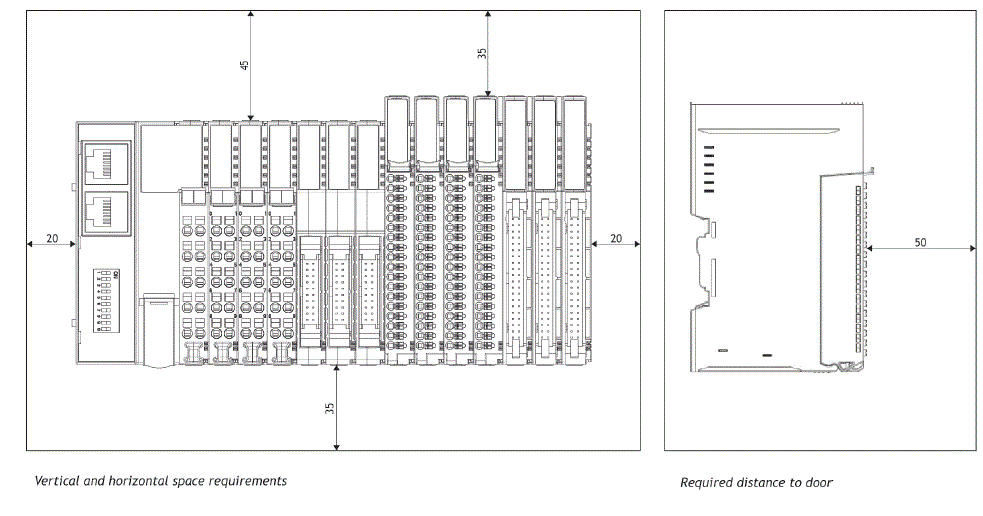
Mount Module to DIN Rail
The following chapters describe how to mount the module to the DIN rail.
CAUTION
The module must be fixed to the DIN rail with the locking levers.
Mount GL-9XXX or GT-XXXX Module
The following instructions apply to these module types:
- GL-9XXX
- GT-1XXX
- GT-2XXX
- GT-3XXX
- GT-4XXX
- GT-5XXX
- GT-7XXX
GN-9XXX modules have three locking levers, one at the bottom and two on the side. For mounting instructions, refer to Mount GN-9XXX Module.
Mount GN-9XXX Module
To mount or dismount a network adapter or programmable IO module with the product name GN-9XXX, for example GN-9251 or GN-9371, see the following instructions: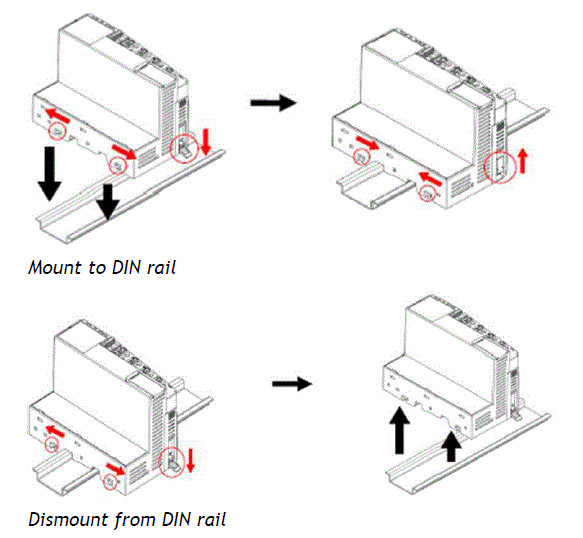
Mount Removable Terminal Block
To mount or dismount a removable terminal block (RTB), see the instructions below.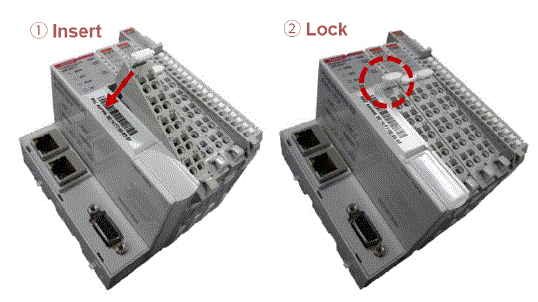
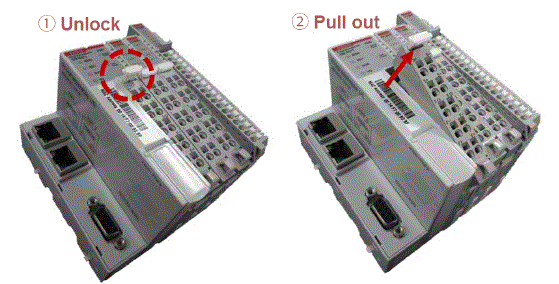
Connect Cables to Removable Terminal Block
To connect/disconnect cables to/from the removable terminal block (RTB), see the instructions below.
WARNING
Always use the recommended supply voltage and frequency to prevent damage to the equipment and ensure optimal performance.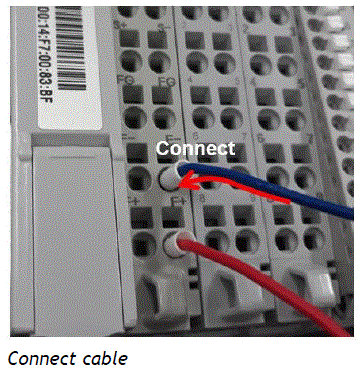
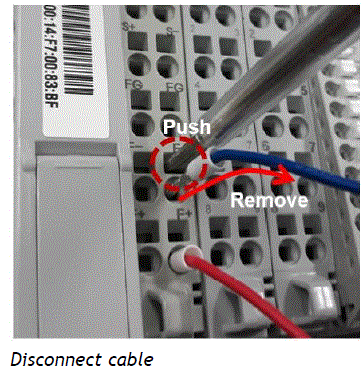
Head Office
- Beijer Electronics AB
- Box 426
- 201 24 Malmö, Sweden
- www.beijerelectronics.com
- +46 40 358600
Documents / Resources
 |
Beijer ELECTRONICS GT-5122 High Speed Counter Module [pdf] User Manual GT-5122, GT-5122 High Speed Counter Module, High Speed Counter Module, Counter Module, Module |